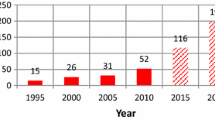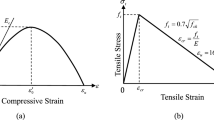Abstract
This paper is a continuation of a previous paper which identified an appropriate mechanically built-up timber girder that could be utilized for bridge construction in countries abundant in timber. In that paper, an existing theory by Ghaboussi was examined and it was detected that the displacement configuration used for shear across the beam depth was in error; thus, while the formula developed for the effective moment of inertia by Ghaboussi was accepted, a new formula had to be derived for the effective area of shear. In this paper laboratory tests are conducted on a test model similar to the girder envisaged, made out of timber in a bid to check the accuracy of the formulae derived in the previous paper. The test results show that the Ghaboussi formula for the moment of inertia gives a good prediction of the true moment of inertia of the girder. However, the Ghaboussi formula for the effective shear area gives a very poor prediction of the true shear area, as is expected. The new formula derived in the previous paper gives a closer prediction, even though there is a need to further close the gap between the experimental results and those of the new theory.
Résumé
On donne ici la suite d'un article qui décrivait une poutre de bois assemblée mécaniquement, utilisable pour la construction de ponts dans des pays riches en bois, mais de technologie peu avancée.
Dans cet article, on examinait la théorie de Ghaboussi et on remarquait que si la formule proposée pour le moment effectif d'inertie était acceptable, la zone effective de cisaillement exigeait une nouvelle formulation.
On a donc entrepris des essais de laboratoire sur une maquette en bois similaire à la poutre afin de vérifier l'exactitude de la formule déduite dans l'article précédent.
Les résultats montrent que pour le moment d'inertie la formule de Ghaboussi permet une prévision valable. Par contre, pour l'aire effective de cisaillement, comme on s'y attendait, elle fournit une très médiocre prévision: presque 17 fois la dimension obtenue au cours de l'essai. La nouvelle formule a donné une meilleure approximation (3 fois celle obtenue au cours de l'essai). Des défauts de fabrication aux connexions devraient expliquer la différence entre la valeur expérimentale et celle résultant de la nouvelle formule.
Similar content being viewed by others
Abbreviations
- A, B, C :
-
Variables used in estimating values of integrals
- A e :
-
Theoretical effective cross-sectional area for axial force
- A e′:
-
Theoretical effective cross-sectional area for shear force
- A f,A w :
-
Area of flange and web in girder cross-section
- b lf,b tf :
-
Widths of lower flange and the top flange in the girder cross-section
- b w :
-
Girder web width
- C :
-
Value of constant term in the strain-load slope against distance plot
- d bl :
-
Depth of the bolt-line from the top of the lower flange
- d es :
-
Elastic support settlement
- E :
-
Young's modulus
- E f,E w :
-
Young's modulus for the flange timber and web timber, respectively
- f 1,f 2,f 3,f 4 :
-
Variables used to compute the theoretical effective shear area
- h :
-
Overall depth of the girder
- h lf,h tf :
-
Depth of the lower flange and the top flange, respectively
- I e :
-
Effective moment of inertia of the girder cross-section
- I w,I f :
-
Moment of inertia of the web and the flange, respectively
- L :
-
Span of the girder
- m :
-
RatioE w/E f
- m dw :
-
Slope of the deflection against load plot
- m ew :
-
Slope of the strain against load plot
- m ewd :
-
Slope of the strain-load slope against distance plot
- M :
-
Bending moment occurring at a point in the girder
- Q :
-
Shear force occurring at a point in the girder
- r :
-
Correlation coefficient of the strain-load slope against distance plot
- s :
-
Distance measured from the top of the girder to a given level
- W :
-
Value of load (kN) at one loading point of the loaded girder
- y :
-
Distance measured from the centrodial axis to a given level in the girder
- δ:
-
Total deflection at a point in the girder
- δA, δB, δC :
-
Total deflection at points A, B and C of the girder, respectively
- ε:
-
Strain at a point in the girder
- σ:
-
Stress at a point in the girder
- μ:
-
Angle of inclination of the web laminations with the horizontal
References
Allotey, I. A., ‘Study into the behaviour of mechanically built-up timber girder for bridge construction’,Mater. Struct. 21 (1988) 256–267.
Ghaboussi, J., ‘Bending of nail-laminated beams of I-Section’, Engineering Institute of Canada EIC-70 BR.STR.12, Vol. 13 No. A-8.
‘Standard Specification for Highway Bridges’, 12th Edn (American Association of State Highway and Transportation Officials, 1977).
‘The Structural Use of Timber’, CP 112 Part 2 (1971). British Standards Institution.
Author information
Authors and Affiliations
Rights and permissions
About this article
Cite this article
Allotey, I.A. Laboratory test on mechanically built-up timber girder for bridge construction. Materials and Structures 23, 372–380 (1990). https://doi.org/10.1007/BF02472717
Issue Date:
DOI: https://doi.org/10.1007/BF02472717




